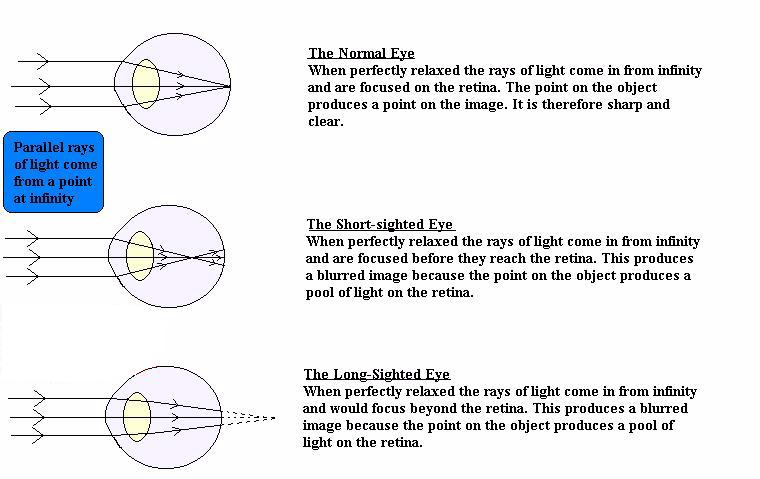PT5; SENSE OF SIGHT
Monday, October 6, 2014 ? 0 Atashinchi ?
1. The sense of sight is the sense that can detect light stimulus.2. Structure of the human eye:
i. the sclera (outermost)
ii. the choroids (middle) and
iii. the retina (innermost)
3. Fucntion of eye;

MECHANISM OF LIGHT
1. The lens in the human eye is a transparent convex lens.
2. An inverted image is focused on the retina.
3. Light rays are refracted by the eye lens. The eye lens focuses the image
onto the retina by changing the thickness of the eye lens. The thickness of
the lens is changed by the ciliary muscles.
i. Focusing near objects
To focus near objects onto the retina, the ciliary muscles
contract. The eye lens become thicker.
ii. Focusing distant object.
To focus distant objects onto the retina, the ciliary muscles relax.
The eye lens becomes thinner.
4. light travels at a speed of ;
i. 300,000,000 meter/second (m/s) in the air.
ii. 225,000,000 m/s in water
iii. 200,000,000 m/s in glass
5.. Light travels in a straight lines.
REFRACTION OF LIGHT
1. Light can be reflected. (that means can change direction)
2. When the reflected light rays enter our eyes, we can see the object.
3. The image in a plane mirror is,
i. virtual (cannot be formed on a screen)
ii. upright
iii. laterally inverted
iv. the same size as the object
v. the same distance behind the mirror as the object is in mirror.
REFRACTION OF LIGHT
1. Refraction of light is the bending of light. This happens when light
travels from one transparent medium to another which is of a different
density.
2. The speed of light decrease when light enters a denser medium.
3. Light travels through media like air, water and glass.

VARIOUS DEFECT OF VISION
1.Two common vision defects are long-sightedness and short-sightedness.

2.Astigmatism is another vision defect.
i. Its caused by the cornea and the eye lens that are not evenly
curved.
ii. As a result, the image formed on the retina is distorted and not
clear (hazy/blurred).
iii. This defect can be overcome by wearing glasses with cylindrical
lenses or contact lens or by surgery.
4. Optical illusion.
i. Optical illusion occurs when the brain cannot interpret
impulses received properly.
5. Blind spot
i. The blind spot is a spot on the retina of the eye that cannot
detect light stimulus.
ii. The image of the object formed at the blind spot cannot be
seen by the eye because there are no light-sensitive cells
(photoreceptors) at the blind spot.
MONOCULAR AND STEREOSCOPIC VISION
1. The stereoscopic vision is vision using both eyes.
2. The overlapping area of the vision of both the left and right eyes is
called stereoscopic field
3. Advantages of stereoscopic vision.
a. See three-dimensional pictures of objects.
b. Enables more accurate estimation of distance and position.
c. Animal predators normally have stereoscopic vision so better
estimate the distance when getting to pounce on their prey.
4. Monocular vision is a vision using only one eye.
5. The advantage of monocular vision is having a wide vision field.
6. Its disadvantage is that it cannot estimate distance accurately.
7. Animal preys use monocular vision to detect predators coming from all
direction.
DEVICES TO OVERCOME LIMITATIONS
Microscope :To see minute objects such as microorganisms and bacteria.
Telescope :To see far-off objects such as stars and planets.
Binocular : To see tiny distant objects such as birds in the sky.
Magnifying: To magnify tiny objects to become glass larger than original.
 Put your cbox or fibox here. Maximum width 240px :)
Put your cbox or fibox here. Maximum width 240px :) Template :
Template : 
